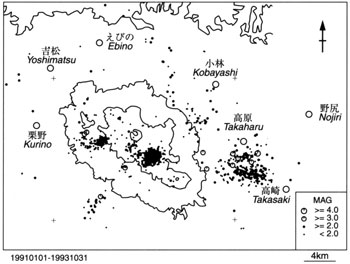Kirishima Volcano
Introduction / Geology of Kirishima Volcano and environs / Topography of Kirishima volcano
History of activities of Kirishima Volcano / Activities of historical times
Monitoring of volcanic activities / Points to be watched for disaster mitigation / Benefit of volcanoes
Acknowledgment / References
![]() PREV
PREV ![]() NEXT
NEXT
Monitoring of volcanic activities / Points to be watched for disaster mitigation / Benefit of volcanoes
Monitoring of volcanic activities
Kagoshima Local Meteorological Observatory has installed a seismograph about 1.7 km SW of Shinmoedake along with regular observation of temperature and compositions of gas at major fumarolic areas. Kirishima Volcanic Observatory of the Earthquake Research Institute of Tokyo University has 15 seismographs, 7 magnetometers, 3 GPS bases, and other instruments installed at many strategic points and engaged in continuous and repeated observations of earthquakes, geomagnetism, fumarolic activity, ground temperature, and crustal movement for promoting prediction of volcanic eruptions ( ![]() Fig. 5 ).
Fig. 5 ).
Geological Survey of Japan, Tokyo Institute of Technology, University of Kyoto, Kagoshima University, and National Research Institute for Disaster Prevention have been involved in temporary observations and surveys. In this map, locations of seismographs installed by Meteorological Agency and Earthquake Research Institute of Tokyo University are plotted.
Points to be watched for disaster mitigation
Eruptions in historical times in Kirishima Volcano occurred at Ohachi, Shinmoedake, and Ioyama. ' Disaster Prevention Map of Kirishima Volcanoes' prepared by combined local governments around the volcano shows possibility of eruption in Ohataike area, where notable earthquakes have been observed, in addition. In the eruptions of historical times, amount of ejecta in terms of rock equivalent ( DRE ) rarely exceeded 1 x 108 m3. In Disaster Prevention Map of Kirishima Volcanoes, DRE exceeding 1.6 x 108 m3 is defined to be large-scale ( possibility of occurrence once for 500 years ), and 4 x 106 m3 to be medium-scale ( once for several tens of years ), and potential danger zones are shown for each scale.
In the eruptions of Shinmoedake during last 300 years, the sequence of events was changed with time from phreatic explosion, to phreatomagmatic, and finally to magmatic. It may be important to remember probable changes of nature of eruptions with time described as above for prediction and mitigation of damage.
In Kirishima Volcano in average, new volcano was born every several thousand years. Similar future trend is expected. At the time of activity of this type, local earthquakes and crustal deformations may precede along with other anomalies. Therefore careful observations are essential. Also in the past large-scale collapse of the mountain occurred at Hinamoridake and Karakunidake. Such large-scale collapse would be catastrophic to affected areas. Those mountains with steep slopes such as Hinamoridake, Ohatayama, Takachiho-no-Mine, and Ohachi should call for extra attentions.
There are many fumarolic alteration areas in Kirishima Volcano. In those areas, phreatic eruptions, landslides, and collapses would commonly be expected. In 1971 near Tearai Hot Spa fumarolic area, landslide and phreatic eruption occurred. In 1980 a section of road collapsed accompanying anomalous outburst of high temperature gas at Iodani area. Also known are burns received when visiting fumaroles and gas poisoning accidents while having bath. Careless approach to fumarole area should be avoided and ventilation while having bath in hot water should be remembered.
Benefit of volcanoes
Kirishima is one of the first designated areas for National Park status in Japan. Many hikers and sightseers visit the area throughout the year to enjoy scenery. Many hot springs are distributed in and around Kirishima and they are rich in varieties. Hot springs in Kirishima are one of the biggest attractions for visitors to southern Kyushu. Geothermal power generation is under operation in this area including Ogiri ( 30,000 kW ) and Kirishima Kokusai Hotel ( 100 kW ). Some of the lava flows are used for stones and tephra such as Kobayashi pumice and Oike pumice are utilized for horticulture.
